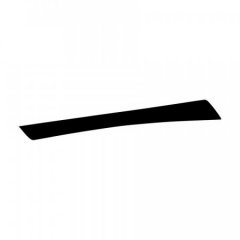Handwriting: The minimum requirements (Part 2)
This series is outdated. I wrote a book about regular script, which I recommend over reading this.
(Continued from Part 1)
Now that you can identify and reproduce all strokes in regular script, it's time to learn to use them correctly. When looking at an example character, observe the writer's intent regarding:
- What kind of stroke is employed.
-
In relation to other strokes and components,
- Where it starts
- What it passes through
- Where it ends
[*]In what order it's written
A note about stroke order: the tl;dr about it is to memorize this list and use Japanese standard stroke order references like this in order to produce correct stroke orders. For more details, read this.
Now I will elaborate a bit about intent. When you try to write 10 of the same character the same way, they will all be different because of human imprecision, although you have the same target character in your mind. The character in your mind is a grapheme (underlying form), and what is written is the surface form. By observing multiple surface forms, you will get a better idea of what the grapheme must be. For example, observe the 1st and 2nd strokes of the many examples of 月 here. In most examples, both of them touch to form a corner. In some examples, they don't touch or almost touch. In even fewer examples, they pass through each other. By observing these examples, one should conclude that they should be ideally touching to form a corner, although if you write 10 of them, and 2 of them look like this:

...and one of them looks like this:

...that's OK. However, no amount of technical deficiency would produce something like this:

Therefore, when writing Chinese characters, it is necessary for your intent to be correct, even if your rendition in some instances is not.
Now let's practice our observational techniques on another character. Look at 大 here. Only look at regular script examples. Here is what I see stroke by stroke:
- In all examples, the first stroke is a 一. I conclude this is the rule.
- In all examples, the second stroke is a 丿 that begins somewhere obviously above the first stroke, centered on it, and passes through it, ending either under the beginning of the first stroke or obviously to the left. In most examples it is obviously to the left. I conclude that ideally it is obviously to the left, although not quite getting there is OK.
- In all examples, the third stroke is a ㇏ beginning at the intersection of the first and second strokes, end extends well past the end of the first stroke, at around the same height as the second stroke. I conclude this is the rule.
Now I try to reproduce it.

- The first stroke is a 一. ✓
- The second stroke is a 丿 that begins somewhere obviously above the first stroke, centered on it, and passes through it, ending either under the beginning of the first stroke or obviously to the left. ✓
- The third stroke is a ㇏ beginning at the intersection of the first and second strokes, end extends well past the end of the first stroke, at around the same height as the second stroke. ✓
If I break the last rule one way or another:


...I will produce wrong characters. On the left I wrote the first stroke too long and/or the last stroke too short. On the right I replaced the last stroke with a 丶, which was in none of the regular script examples.
Now that you know how to write 大, you can use it to learn other characters that contain it, like 天 or 太. Let's look at 太 here.
- The majority is written like 大. Since you know that already, there is no need to relearn.
- There is a 丶 placed between the 2nd and 3rd strokes. Most examples place it directly under the intersection (and not halfway between the 2nd and 3rd strokes).
More on that last point, observe this. The dot is placed under the intersection. If it were halfway between the 2nd and 3rd strokes, it would be to the right of the intersection. Technical imprecision can produce a dot that goes anywhere in the area between the 2nd and 3rd strokes, but most examples seem to aim directly under the intersection. Also, some learners who are used to looking at modern typefaces will likely have a grapheme in their heads with the dot attached to the 2nd stroke, even if it ends up left of the intersection. This is because modern Chinese regular script typefaces render it so. Here is DFKai-SB:

Compare with a Japanese typeface Epson 正楷書体M:

Although technical imprecision could cause someone meaning to put it under the intersection to attach it to the 2nd stroke, an intent to do so is inaccurate. One can avoid this by always using good examples. Unfortunately, the best examples are rarely presented to beginners. The tl;dr about good examples is go to a 書法字典 like 9610.com, search for what you want (in Simplified Chinese), and prioritize 歐陽詢, 顏真卿, and 柳公權, being careful not to learn a wrong character because they are misclassified. This might seem like a lot of work, but if you do it, you will find that you will only need to look up simple characters, as complex characters are made of simple components. Furthermore, it isn't much additional work if you are learning characters, as observing example characters in detail only strengthens your character memory.
(Continued in Part 3.)



0 Comments
Recommended Comments
There are no comments to display.